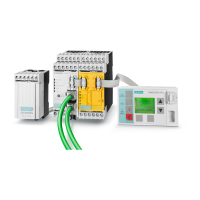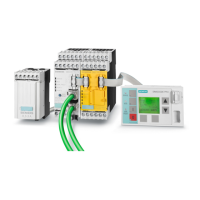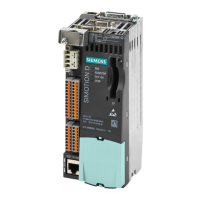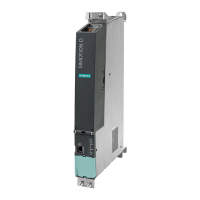Standard functions
SIMOCODE pro
10-20 GWA 4NEB 631 6050-22 DS 03
SIMOCODE pro Safety" manual).
The basic unit compares the set position (from the download) with the
actual position at the DM-F Local. If these differ "Configuration deviation" is
output!
Settings of the DIP switches (DM-F Local)
DIP switches (DM-F Local) Description
With/without cross-circuit detection Cross-circuit detection is only possible with
potential-free sensors. In this case, the
sensors must be connected between T1 - Y12,
Y33 and T2 – Y22, Y34. The device anticipates
the T1 terminal test signal on terminals Y12
and Y33. Likewise, the T2 terminal test signal
is anticipated on terminals Y22 and Y34. In the
event of the signals on Y12, Y33 or Y22 , Y34
not corresponding to the T1 and T2 test
signals, the device detects a sensor fault.
When electronic sensors such as light arrays or
laser scanners are connected, cross-circuit
detection must be disabled. The DM-F Local no
longer monitors the sensor inputs for cross
circuiting. Usually, the outputs of safety
sensors (OSSD) are monitored for cross
circuiting in the sensor itself.
When the device has been parameterized as
"without cross-circuit detection", the T1 and T2
test outputs are switched off and must not be
reconnected. The DM-F Local anticipates a
+24 V DC signal from the same current source
from which the device is powered on inputs
Y12, Y22, Y33 and Y34 (DM-F Local-*1AB00
only) or from T3 (static +24 V DC).
With the DM-F Local-*1AU00 device version,
terminal T3 must be connected to the
potential-free sensor contacts, due to the
galvanic isolation of the input circuit and the
sensor supply.
1 NC contact + 1 NO contact
evaluation/2 NC contact evaluation
In addition to the 2-channel connection of
aligned sensor contacts (NC/NC), sensors with
opposing contacts (NC/NO – often used for
magnetically-operated switches) can also be
evaluated. In this case, please ensure that the
NC contact is connected to Y12 and the NO
contact is connected to Y22.
2x 1-channel/1x 2-channel • 2 sensors, each with one contact (2x 1-
channel) (NC/NC). Here, the sensors are
"AND"-connected with one another.
Simultaneity is not monitored.
• 1 sensor with 2 contacts (1x 2-channel) (NC/
NC). Here, it is expected that both contacts
open simultaneously.
Table 10-12: Settings of the DIP switches (DM-F Local)

